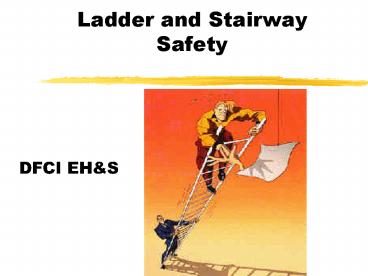Ladder and Stairway Safety - PowerPoint PPT Presentation
1 / 7
Title:
Ladder and Stairway Safety
Description:
Type I 250 Pound Industry & light construction. Type II 225 Pound Commercial ladder for light maintenance ... Loose nails, screws, bolts, or other metal parts? ... – PowerPoint PPT presentation
Number of Views:1171
Avg rating:3.0/5.0
Title: Ladder and Stairway Safety
1
Ladder and Stairway Safety
- DFCI EHS
2
Ladder selection
- Type IA 300 Pound Construction areas
- Type I 250 Pound Industry light
construction - Type II 225 Pound Commercial ladder for light
maintenance office use - Type III 200 Pound Household use
3
Ladder Inspection
- Loose steps or rungs (considered loose if they
can be moved at all with the hand)? - Loose nails, screws, bolts, or other metal parts?
- Cracked, spilt, or broken uprights, braces, or
rungs? - Slivers on uprights, rungs, or steps?
- Damaged, worn or missing non-slip bases?
- Wobbly (from side strain)?
- Loose or bent hinge spreaders?
- Stop on hinge spreaders broken?
- Loose hinges?
- Broken, split, or worn steps?
4
Ladder Safety- What this Guy Should Know
- Keep tools in a tool belt.
- Any heavy or bulky items should be brought
- up only after you have reached the top.
- Make sure the ladder's feet are parallel to
- the surface it rests against.
- Use both hands to climb a ladder. Remem-
- ber the "3-Point Rule" At least two hands
- and one foot, or two feet and one hand, should
- be in contact with the ladder at all times.
- Avoid excessive stretching or leaning.
- Always face the ladder when climbing,
- descending or working.
- Do not use a ladder for unintended purposes,
- such as in place of scaffolding.
- Never allow more than one person on a
- ladder at a time.
5
Safety Rules - or- Gravity is a Harsh Mistress
- Do not try reaching so far that you lose your
- balance move the ladder.
- Non-skid feet or spurs may prevent a ladder
- from slipping on a hard, smooth surface.
- Do not stand on the ladder's top three rungs.
- The ladder should reach a minimum of three
- feet above the "point of support.
- Keep your body between the side rails of
- the ladder. This reduces the chance of tipping it
- over and/or falling off.
6
The 1-to-4 Rule
- The base should be spaced 1 foot away for
- every 4 feet it reaches up.
- Extension ladders need both locks in place to
- prevent overloading a rail.
- Step ladders should be securely spread open.
- Electrical shock can occur with metal or wet
- wooden ladders. Not only is the shock itself
- dangerous, but it can cause falls resulting in
- injury.
7
The Good, The Bad and The Ugly
?































